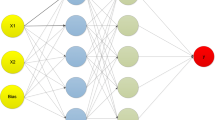Abstract
The occurrence of every earthquake has an enormous impact on society and the human community. Thus, there is a need to develop effective methodologies to analyze the spatiotemporal distribution in earthquake-prone regions. In this paper, a three-stage hybrid model based on Fuzzy C-Means (FCM) and Density Peak Clustering (DPC) algorithm is proposed for this analysis. The proposed model considers coordinate, occurrence time, event’s magnitude, and depth for identifying the earthquake aftershock clusters and the background events present in an earthquake catalog. The seismicity analysis of the Philippines and New Zealand earthquake regions is carried out using the proposed model considering the last 30-years data from 1990 to 2020. The obtained results with the proposed model reveal that background events follow a uniform distribution in a short time interval, whereas aftershocks have time-varying distribution in accordance with the occurrence of the main shocks. Comparative analysis has been demonstrated with five other benchmark de-clustering models proposed by Gardner and Knopoff (GK), Uhrahemmer, Raesenberg, Gruenthal, Vijay, and Nanda, respectively.
Access this chapter
Tax calculation will be finalised at checkout
Purchases are for personal use only
Similar content being viewed by others
References
Gardner JK, Knopoff L (1974) Is the sequence of earthquakes in southern california, with aftershocks removed, poissonian? Bull Seismol Soc Am 64(5):1363–1367
Uhrhammer RA (1986) Characteristics of northern and central california seismicity. Earthq Notes 57(1):21
Reasenberg P (1985) Second-order moment of central california seismicity, 1969–1982. J Geophys Res: Solid Earth 90(B7):5479–5495
Wiemer S (2001) A software package to analyze seismicity: Zmap. Seismolo Res Lett 72(3):373–382
Vijay RK, Nanda SJ (2017) Tetra-stage cluster identification model to analyse the seismic activities of japan, himalaya and taiwan. IET Signal Process 12(1):95–103
Di Martino F, Pedrycz W, Sessa S (2018) Spatiotemporal extended fuzzy c-means clustering algorithm for hotspots detection and prediction. Fuzzy Sets Syst 340:109–126
Davoudi N, Tavakoli HR, Zare M, Jalilian A (2018) Declustering of iran earthquake catalog (1983–2017) using the epidemic-type aftershock sequence (etas) model. Acta Geophys 66(6):1359–1373
Cho NF, Tiampo KF, Mckinnon SD, Vallejos JA, Klein W, Dominguez R (2010) A simple metric to quantify seismicity clustering. Nonlinear Process Geophys 17(4):293
Nanda SJ, Tiampo KF, Panda G, Mansinha L, Cho NF, Mignan A (2013) A tri-stage cluster identification model for accurate analysis of seismic catalogs. Nonlinear Process Geophys 20(1):143–162
Rahul Kumar Vijay and Satyasai Jagannath Nanda (2019) Shared nearest neighborhood intensity based declustering model for analysis of spatio-temporal seismicity. IEEE J Sel Top Appl Earth Obs Remote Sens 12(5):1619–1627
Vijay RK, Nanda SJ (2017) Declustering of an earthquake catalog based on ergodicity using parallel grey wolf optimization. In: 2017 IEEE congress on evolutionary computation (CEC). IEEE, pp 1667–1674
Vijay RK, Nanda SJ (2019) A quantum grey wolf optimizer based declustering model for analysis of earthquake catalogs in an ergodic framework. J Comput Sci 36:101019
Khare P, Nanda SJ, Vijay RK (2019) Clustering networks based on physarum optimization for seismic catalogs analysis. In: 2019 IEEE congress on evolutionary computation (CEC). IEEE, pp 2864–2871
Vijay RK, Nanda SJ (2019) A variable epsilon-dbscan algorithm for declustering earthquake catalogs. In: Soft computing for problem solving. Springer, pp 639–651
Vijay RK, Nanda SJ (2020) Seismicity analysis using space-time density peak clustering method. Pattern Anal Appl 1–21
Zhu L, Chung F, Wang S (2009) Generalized fuzzy c-means clustering algorithm with improved fuzzy partitions. IEEE Transac Syst Man Cybern Part B 39(3):578–591
Rodriguez A, Laio A (2014) Clustering by fast search and find of density peaks. Science 344(6191):1492–1496
NCEDC (2014) Northern california earthquake data center
Author information
Authors and Affiliations
Corresponding author
Editor information
Editors and Affiliations
Rights and permissions
Copyright information
© 2021 The Author(s), under exclusive license to Springer Nature Singapore Pte Ltd.
About this paper
Cite this paper
Sharma, A., Nanda, S.J., Vijay, R.K. (2021). A Model Based on Fuzzy C-Means with Density Peak Clustering for Seismicity Analysis of Earthquake Prone Regions. In: Tiwari, A., Ahuja, K., Yadav, A., Bansal, J.C., Deep, K., Nagar, A.K. (eds) Soft Computing for Problem Solving. Advances in Intelligent Systems and Computing, vol 1393. Springer, Singapore. https://doi.org/10.1007/978-981-16-2712-5_16
Download citation
DOI: https://doi.org/10.1007/978-981-16-2712-5_16
Published:
Publisher Name: Springer, Singapore
Print ISBN: 978-981-16-2711-8
Online ISBN: 978-981-16-2712-5
eBook Packages: Intelligent Technologies and RoboticsIntelligent Technologies and Robotics (R0)




